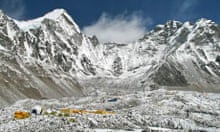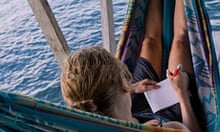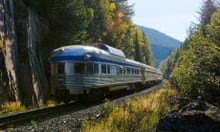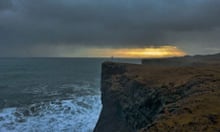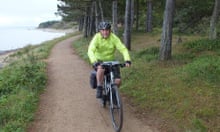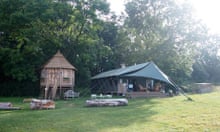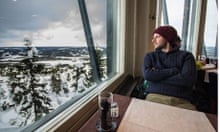The ferry got lost on the way from Angra dos Reis to Ilha Grande. Perhaps it was the relative youth of the wheelman, or perhaps it was the tropical downpour that had melded sea and sky into an impenetrable grey veil off the Costa Verde. Rusting buoys materialised periodically, bobbing askew. Horizontal spray lashed ponchoed backpackers in the rear seats. I'm sure we sailed in a circle at one point.
When the island finally appeared to the south, cloud-wraithed and shadowy, it looked like something Charles Marlow might have narrated in a Joseph Conrad novel. Here was a place that lived up to its dark history of piracy, as penal colony and quarantine hospital. Just 11 miles and an hour or so from the mainland, it might as well have been the shore of some lost continent.
Ilha Grande's only town, Abraão, is an assortment of low-level buildings scattered beneath the foliage-choked peak of 982m Bico do Papagaio (Parrot's Peak). The streets were rivers when we disembarked, and we walked to our pousada ankle-deep in muddy water streaming down from the hills. Shop fronts dripped rainwater curtains. Umbrellas jostled. But the deluge was warm – almost blood temperature.
The Mata Nativa pousada is a gathering of A-frame huts amid banana, palm and jackfruit trees. Each hut has a hammock to string across its front, but we sheltered inside and listened to the hammering rain as darkness fell. Others might have felt bedraggled and morose, but we were excited. This was tropical, apocalyptic rain. Our shelter was warm and dry.
With night fallen and the storm only increasing, we splashed back into town in total darkness (the generators were down) and chose the Frutos do Mar restaurant to try the traditional moqueca fish stew with a bottle of Bohemia, Brazil's oldest beer. The meal arrived in a black earthenware pot whose temperature, once the lid was removed, continued to reduce the rich palm oil and coconut sauce as we ate chunks of white fish, prawns, green peppers and tomato. Served with white rice, it was easily enough for two. We slept full, and lulled by the relentless torrent.
Dawn came with chirrups, cries, whistles, rattles, sirens, warbles and chatters: the forest alive after the downpour. About 10 inches of rain had fallen overnight. Breakfast in the big wooden hut was the usual Brazilian fare: cakes, crackers, cereal, sliced meat and cheese. It's the fruit that's unbelievable: mangoes, pineapple, passion fruit, papaya and the remarkable guava that make their relatives in British supermarkets look pale and sickly in comparison. After that, we were ready for some walking.
The island is a protected area, most of it part of the Ilha Grande nature reserve. There are no cars, no ATMs, intermittent internet access and phone signals and, occasionally, no electricity. Tourism only began here in the 1990s and development remains slight. At least for now – but for how long given the island has 193 sq km of pristine Atlantic rainforest fringed by wild beaches and criss-crossed by 150km of jungle pathways.
West along the beach from Abraão are the eerie ruins of the leprosy hospital that became a prison for political nay-sayers. Further inland, the ruins of the aqueduct that supplied the building are being slowly absorbed by the forest. Further still, a waterfall is a good place to cool off and soothe any bites.

We headed east along the beach, where black vultures perch on pilings holding their wings out to dry, and where a stream cuts through the sand to the sea. Everything dripped. The sand was rain-pocked. Bico do Papagaio glowered above the steaming jungle. Our destination was Lopes Mendes beach on the other side of the island – a regular candidate in world's best beach lists. It can be reached by regular boat trips from Abraão (20 reais, about £5), but we were hiking the five-hour round trip.
Barely minutes into the greenery, you know you're in a genuine rainforest. The clay earth is root-riven and orange. Bamboo as thick as thighs shoots up in deep green fans. Trees are festooned with liana vines and dangling mosses. Unearthly birds sing and shoot like coloured sparks among the leaves. The howler monkey's terrifying, bubbling gargle sounds like a creature you wouldn't like to meet face to face. And the humidity … the humidity stifles breath and encourages perspiration that drenches whatever clothes you're wearing. One must take water. A lot of water.
On the path, we met locals who use it to move between settlements in the same way indigenous Tamoio people once must have: an old man selling woven hats, a pregnant girl with a walking staff, a sinewy guy wearing nothing but Speedos and carrying an oar. No backpacks or hi-tech walking shoes for them; flip-flops are apparently de rigueur on the track.
The route took us up and down steep inclines, through patches of fallen jackfruit whose lavatorial reek attracts swarms of flies, and from beach to beach. The first is Praia de Palmas, accessed by rope down a sloping boulder. There are just a few ramshackle huts and cafes along a mostly empty stretch of coarse sand littered with palm fronds – the kind of beach a shipwrecked mariner might wake up on. The next is Praia do Pouso, smaller and with a jetty to receive the Lopes Mendes boats from Abraão, Lopes Mendes itself usually being too rough to accommodate a landing.
You hear the beach before you glimpse it: massive Atlantic breakers roaring through the trees. The orange clay changes to fine sand and the trees thin to reveal whiteness ahead. It's no Copacabana or Ipanema – no place for deckchairs, ice-cream stalls and thongs. This is edge-of-the-world stuff: a vast swathe of empty sand with the great static wave of greenery behind it. Sea spray obscures its furthest end to the east, while the west is all foaming rocks. The surf curls in green tubes and explodes. The cross-currents are absolutely lethal, whipping your legs away if you wade too far. Signs warn swimmers of the danger.
The sand is supernatural. Finer than salt, it's so densely packed that your weight makes no impression. Footprints lie on its surface as transfers and it squeaks beneath the sole like dense snow. Scuff your heel, and it seems to whistle. It shelves gradually, almost level and without stones, to the cauldron of the surf.
It was here that we saw the capuchin monkeys larking in the branches by the shore. They seemed happy to pose for pictures, clinging to the branches and observing their observers with apparent wit. They're sticking their tongues out on many of our pictures.
The walk back was, frankly, a killer. We arrived clay-caked, gnat-bitten and reeking, but Abraão had dried and come alive in our absence. A cruise ship had called and the beachfront cafes were packed. The inevitable Bob Marley CD drifted through the palms and made the backpacker vibe complete. Coming from the intensity of Rio or São Paulo, it's a great place to relax, walk, eat, swim and drink caipirinhas in a hammock.
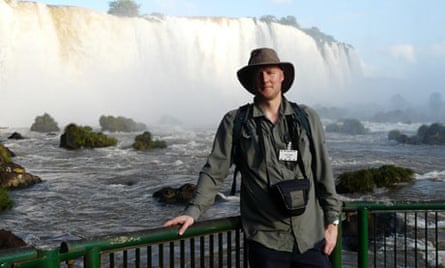
After dark, the cobbled streets of the centre offer a low-key night out. Live music seems to come from every bar and the kilo restaurants do a good trade. At these, you select what you want from a buffet and pay by weight. We went to the Biergarten restaurant, where the selection included good fish, meat, salads and desserts that encouraged us to pile the plates high and finish them with gut-busting gusto.
It was also in Abraão that we first experienced "cakemobiles": large wheeled boxes with a Perspex lid, containing about 10 different desserts: cakes of heart-seizing calorie content, made variously with syrup, coconut, chocolate, nuts and sponge. Prince among them must be the brigadeiro: a ball of chocolate fondant covered in chocolate sprinkles. Exerting its own gravity, this oozing chocoholic bomb melts on the tongue. I believe I ate a dozen while in Brazil.
It was a short – too short – stay. With Bico do Papagaio receding into the haze behind us, I took away the island's clay on my trousers, its rain still dampening my backpack, its gnat bites on my ankles, its sand in my shoes and its sights in my camera. Oddly, it's the brigadeiros I miss as I sit writing with my trouser button undone and the suntan already fading.
G Adventures (0844 272 2040, gadventures.co.uk) provided this Best of Brazil nine-day group tour to Paraty and Ilha Grande, Iguaçu Falls and Rio de Janeiro. It costs from £1,549pp, including accommodation, breakfast, transfers and some activities, but not flights

